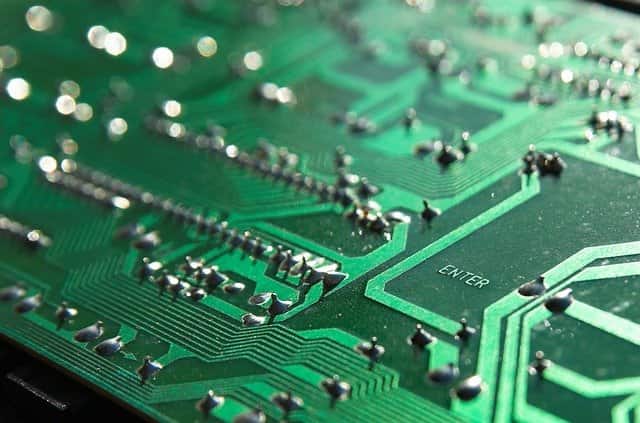Selecting lead-free PCB manufacturing materials or rather, those that comply with the RoHS Directive, also requires considering the capability of the material to withstand high temperatures, and the compatibility of solder and PCB pad coatings. The primary objective of the RoHS Directive is to limit the use of cadmium, mercury, polybrominated biphenyls, hexavalent chromium, and polybrominated biphenyl ethers in restricted concentration levels. We, at Rush PCB, use raw materials and processes that meet the above restrictions.
Lead-Free PCB Material Characteristics
PCB materials that comply with the RoHS Directives cannot use regular solder paste made with Lead and Tin alloy. They must necessarily undergo a soldering process that uses Lead-free solder paste. As this process requires the PCB to undergo soldering at high temperatures, the basic PCB material must remain stable at those temperatures.
Therefore, the lead-free PCB material must primarily have a high glass transition temperature, and a high PCB decomposition temperature, along with a low thermal expansion coefficient. Other requirements for the PCB material are good electrical properties such as low dielectric loss, low dielectric constant, high insulation resistance, low water absorption, and most importantly low cost.

Choosing a lead-free PCB Material
A complex product typically needs an advanced lead-free PCB with materials that satisfy the above characteristics. As the complexity of the product increases, the PCB will also have a larger surface area, a greater number of layers, and a larger number of components. In addition, the quality of the board must also be high. Therefore, engineers have some thumb rules when choosing materials for a lead-free PCB, primarily according to product function, product grade, and performance index:
- For general electronic products, use lead-free FR-4 epoxy glass fiber substrate
- For complex electronic products, use lead-free high Tg FR-4 material (150-170 °C)
- For high-reliability electronic products, use lead-free FR-5 material
- For low-cost electronic products, use lead-free CEM-1 and CEM-3 materials
- For high-temperature or flexible circuits, use Polyimide glass fiber substrate
- For high-reliability circuit boards requiring high-heat dissipation, use metal substrates
- For high-frequency circuit boards, use Teflon glass fiber substrates
Rush PCB presently produces both small and production quantity or PCBs that meet the RoHS Directive. To achieve this goal, we make our printed circuit boards not only lead-free, but also ensure the concentration levels for cadmium, mercury, polybrominated biphenyls, hexavalent chromium, polybrominated diphenyl ethers, chlorine, and bromine are within the concentration levels dictated by the Directive.
Accordingly, any board that Rush PCB produces uses only lead-free solder processing. For the finishing, we use immersion gold, electroless nickel, electroplated gold, or white tin. As an ISO 9001:2015 company, Rush PCB works closely with our customers and suppliers to identify and use material that complies with the RoHS Directive.
Read About: ADVANTAGES AND DISADVANTAGES OF PCB SURFACE FINISHES
Lead-Free Laminates
We have added many high-temperature laminates to our inventory, as this allows us to meet the high-temperature cycling requirements for some of our customers with lead-free assembly applications.
It is important to note that some lead-free assembly processes require the laminate base material to withstand temperatures exceeding 260 °C for extended periods of time.
Rush PCB also has UL approval for processing material with high thermal capacity that meet the UL testing requirement for a maximum operating temperature of 130 °C, soldering limits of 288 °C for 20 seconds, and 94-V0 flame rating. Each laminate systems that we use conforms to the minimum requirements of IPC 4101A specification sheets 24, 26, or 28. However, variations in electrical, physical, and thermal properties may exist in material types even from an individual manufacturer.
Several types of lead-free laminates are available in the market. Some of the most popular ones are:
| Product | Resin Matrix | Tg (°C) | Td (°C) | T-288 (Mins) | CTE % (Z axis) |
Dk @ 2 GHz |
Df @2 GHz |
| Standard Material | |||||||
| Polyclad 370HR |
Phenolic Epoxy |
180 | 350 | pass | 2.7 | 4.4-4.7 | 0.018-0.021 |
| Iteq IT-180TC | Phenolic Epoxy |
180 | 385 | >10 | 3.0 | 4.2-4.7 | 0.018-0.021 |
| Isola IS410 | Phenolic Epoxy |
180 | 350 | >15 | 3.5 | 4.2-4.7 | 0.018-0.021 |
| Low Loss Material | |||||||
| Polyclad Getek | Polyphenylene Oxide | 345 | 175 | pass | 3.8 | 3.5-3.7 | 0.009-0.011 |
| Isola FR408 | Modified Epoxy | 360 | 180 | >15 | 3.5 | 3.55-3.6 | 0.011-0.0125 |
| Isola FR415 | Non-Phenolic / Non-dicey | 370 | 180 | >20 | 2.9 | 3.8-3.9 | 0.016-0.017 |
| Ultra Low Loss Material | |||||||
| Nelco-13SI | Enhanced Epoxy | 365 | 210 | pass | 3.5 | 3.3-3.4 | 0.007-0.008 |
| Polyclad 621 | Polyphenylene ether | 400 | 210 | pass | 3.0 | 3.3-3.55 | 0.0045-0.007 |
| Isola IS620 | Low Dk/Df | 353 | 215 | >15 | 2.8 | 3.55-3.6 | 0.008 |
| Rogers RO4350 | Hydrocarbon ceramic | 395 | 300 | >180 | <3.0 | 3.48 | 0.004 |
Lead-Free Soldermask and Surface Finish
Most manufacturers use soldermask containing chlorine. Rush PCB uses halogen-free soldermask for all lead-free PCBs.
Read About: SURFACE FINISH OF PCBS AND SOLDERABILITY
Conclusion
Rush PCB is a leader in the Printed Circuit Board industry, and we have committed to taking an active role in working closely with our customers and suppliers for identifying and rapidly eliminating hazardous substances from all products we use. As Rush PCB is an ISO 9001:2015 registered company, we fully support the efforts of the electronics industry worldwide to phase out the use of lead and other hazardous elements.





